|
|
|

Lophophora diffusa
|
|
Description:
Globular spineless cactus with large
tap root. Solitary or forming variable stemmed clumps with few stems or
sometime large mounded group with several heads. This is the more
primitive species of Lophophora.
Stem:
2-7 cm tall, 5-12 cm in diameter (some population have larger stems up
to 20-25 cm in diameter) Yellow-green or grey-green, usually lacking
well-defined ribs and furrows.
Ribs:
5 to 13 the
podaria are rarely elevated, wavy, broad and flat.
Areoles:
With tufts of hairs that usually spread unequally on the prominent
podaria.
Flowers:
Commonly whitish to yellowish-white
(or pinkish white), 1,5-3 centimetres in diameter.
|
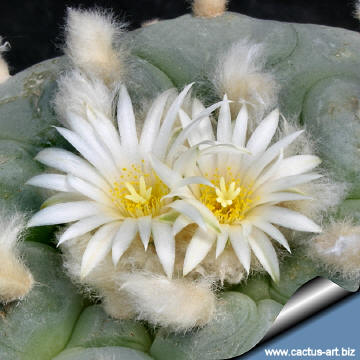
L. diffusa VM 205 North of Vizarrón, QRO, Mx. |
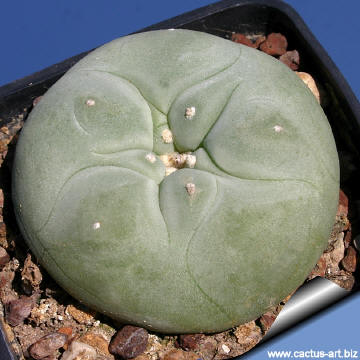
L. diffusa VM 23 Queretaro, QRO, Mexico |
|
. |
|
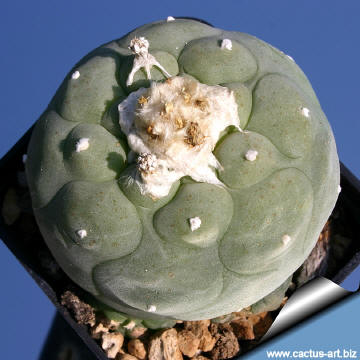 |
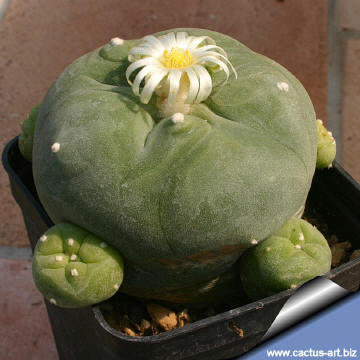 |
|
. |
|
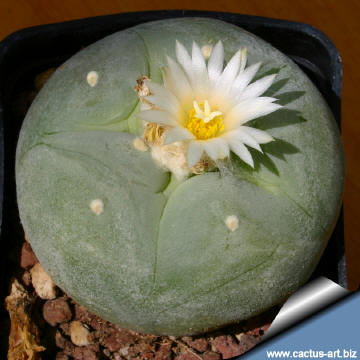 |
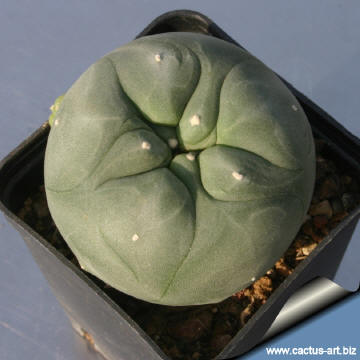 |
|
Advertising
|
|
|
|
|
Family:
Cactaceae (Cactus
Family)
Scientific Name: Lophophora
diffusa
(Croizat) Bravo
Published in: Cact. Succ. Mex. 12: 13, 1967
Etymology:
diffusa = outspread; with regard to the flat
tubercles that are outspread on the plants body without clear ribs or
evident spiral.
Common Name: False peyote.
Origin:
This is the southernmost population of Lophophora endemic of the of the
state of Querétaro, México it grows only in a small area in the hight
desert between Vizarron, Bucareli, and Toliman. L. diffusa occurs at the
south end of the range of the genus.
Habitat:
Driest and stoniest desert Xerophytic shrubland. L. diffusa grows mainly
beneath the canopy of some locally dominant shrub and possible
nurse plant (e.g. Larrea tridentata and Acacia sororia)
Conservation status: Listed in
CITES appendix 2.
This is a relative of
Lophophora williamsii, the true Peyote. It has many morphological and chemical
differences and does not contain the same substances as L. williamsii. This species contains none to trace amounts of mescaline as the
Peyote. But it does contain a lot of other alkaloids the principal of
which is pellotine. It is not narcotic and is not
specifically named in the law, and probably legal to possess.
Synonyms:
- Lophophora echinata var. diffusa Croizat 1944
- Lophophora williamsii var. diffusa (Croizat) Rowley
1979
- Lophophora diffusa var. koehresii Riha 1996,
- Lophophora williamsii var. koehresii (Riha) Grym
1997
- Lophophora diffusa subsp. viridescens Halda 1997,
- Lophophora viridescens (Halda) Halda 1997
- Lophophora diffusa var. fricii Halda 1997
- Lophophora diffusa var. kubesai Halda, Kupcak et
Malina
- Lophophora diffusa var. swobodaiana Halda, Kupcak et
Malina
- Lophophora ziegleri Werdermann
- Lophophora ziegleriana Soulaire
|
|
|
|
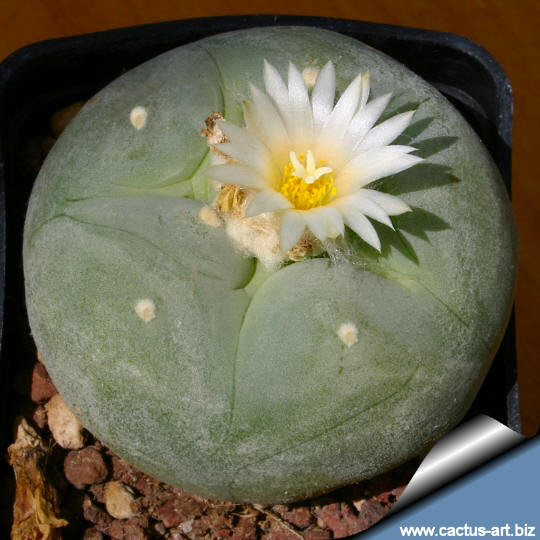
Cultivation: Slow growing Requires half
shade in summer, full sun the rest of the year.
Grow it in a narrow and
deep container to accommodate the tap root, they are very rot prone, so
use highly gritty compost with much drainage.
Waterings should be rather infrequent to keep the plant compact and not
to become excessively elongated and unnatural in appearance, watering it
properly is often difficult because this plant tends to crack open or
rot if over-watered. The fact that the plant retracts into the soil and
assume a grey-green colouring between watering, is perfectly natural and
doesn’t cause any damage.
Like other arid zone cacti, they require a dry
and cool over-wintering otherwise they may succumb to rot. It also
promotes flowering. Assure a good ventilation.
Propagation: Seeds.
Seed should be sown in spring in sterile
cacti mix. Cover with a humidity dome or plastic wrap and leave in a
warm spot in 50-75% shade. Fluctuating temperatures are best (ie. high
day temperature and low night temperature) as they simulate the desert
environment.
Keep constantly humid as seedlings cannot survive if to
dry. Seedlings will emerge in 7-21 days and can be grown in the same
environment for a number of months. Mulch with thin layer of small
quartz gravel (1-2mm diameter) this helps them stay upright, hinders
algae growth and regulates moisture. As they get older the watering can
become less frequent. Potting up can be done when 5-10mm in diameter.
Photo of
conspecific taxa, varieties, forms and cultivars of Lophophora
diffusa.

 |
|